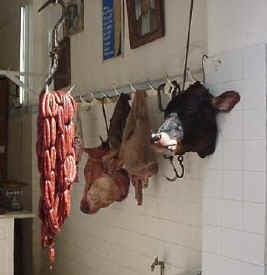 |
 |
 |
The Gulf of Hammamet contains many of the eastern coastal resorts of Tunisia, extending from just below Cap Bon on the north to the flat Sahel coast. We visited ports at Kélibia, Hammamet, Port el Kantaoui near Sousse, and Monastir.
 |
Sousse is the third largest city in Tunisia and one of the oldest ports in the Mediterranean, founded in the ninth century BC by the Phoenicians. Like most cities, Sousse has an old médina, and most of its original fortifying walls are intact. At left is the Grand Mosque, which is one of the few mosques that are open to visitors. Notice the characteristic keyhole shape of the arches, which is typical also on homes and all types of buildings in Tunisia. |
|
|
|
|
The médina always has a large food section, and Sousse is no exception, with wide aisles and attractive stalls. At right, the fishmonger has spread the gills of his merchandise to demonstrate its freshness. A meat vendor hangs the heads of the animals killed daily. Spices are sold in bulk, including saffron, which is a common ingredient and very inexpensive. |
 |
 |
 |
 |
The Ribat of Harthouma at Monastir dominates the approach by sea. This eighth century fortification is in such excellent condition that it is featured in movies such as Monty Python's The Life of Brian, as well as Raiders of the Lost Ark, and the serial Jesus of Nazareth. |
|
Monastir is most famous as the birthplace of Habib Bourguiba, the leader of Tunisia's successful mid-twentieth century independence movement and its first president. Bourguiba's leadership contributed greatly to modern Tunisia's economic strength and its cultural progressiveness. The mausoleum pictured at right is President Bourguiba's final resting place since his death in 2000. |